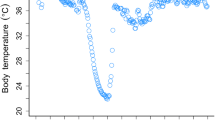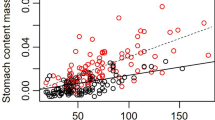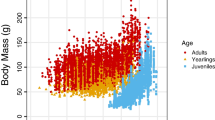Abstract
Different environments are expected to exert differential selective pressures, often generating distinct sets of traits in organisms inhabiting different geographic regions. Starvation endurance is an important trait for organisms in harsh (i.e., extreme climate and/or biotically poor) and unpredictable environments. This is especially true for sit-and-wait predators, such as antlions, which experience stronger fluctuations in prey arrivals than do actively searching predators. We conducted an experimental comparison of starvation endurance in pit-building antlions, originating from semi-arid and hyper-arid environments. We hypothesized that individuals from the climatically harsher and biotically poor environment (i.e., hyper-arid) should be better adapted to endure long starvation periods. Additionally, we posited that faster-growing individuals are expected to be more sensitive to starvation because of their need to sustain higher metabolic rates. We found that antlions originating from the semi-arid region maintained higher activity levels, which led to slightly higher mass loss rates during starvation, but enabled faster recovery when food supply was renewed. Conversely, antlions originating from the hyper-arid region had lower activity levels, consistent with their lower rate of mass loss during starvation, but this came at the expense of decreased response to prey and lower growth rate when food became available again. Each strategy holds its advantages for coping with long starvation periods, and we cannot say decisively which strategy is better. Results from both regions were consistent with the predictions of the growth compensation phenomenon: antlions that were fed less frequently pre-starvation grew at faster rates when food supply was renewed. Our study demonstrates that individuals originating from different environments adopt different strategies in order to endure starvation, exemplifying antlions’ ability to compensate for mass lost during starvation.





Similar content being viewed by others
References
Abramsky Z (1988) The role of habitat and productivity in structuring desert rodent communities. Oikos 52:107–114
Allan E, Pannell JR (2009) Rapid divergence in physiological and life-history traits between northern and southern populations of the British introduced neo-species, Senecio squalidus. Oikos 118:1053–1061
Applebaum SW, Heifetz Y (1999) Density-dependent physiological phase in insects. Annu Rev Entomol 44:317–341
Arnett AE, Gotelli NJ (2003) Bergmann’s rule in larval ant lions: testing the starvation resistance hypothesis. Ecol Entomol 28:645–650
Atkinson D (1994) Temperature and organism size - a biological law for ectotherms. Adv Ecol Res 25:1–58
Atkinson D, Sibly RM (1997) Why are organisms usually bigger in colder environments? Making sense of a life history puzzle. Trends Ecol Evol 12:235–239
Barkae ED, Scharf I, Subach A, Ovadia O (2010) The involvement of sand disturbance, cannibalism and intra-guild predation in competitive interactions among pit-building antlion larvae. Zoology 113:308–315
Barkae ED, Scharf I, Abramsky Z, Ovadia O (2012) Jack of all trades, master of all: a positive association between habitat niche breadth and foraging performance in pit-building antlion larvae. PLoS ONE 7:e33506
Bateson P, Barker D, Clutton-Brock T et al (2004) Developmental plasticity and human health. Nature 430:419–421
Blanckenhorn WU (2000) The evolution of body size: what keeps organisms small? Q Rev Biol 75:385–407
Buxton PA (1924) Heat, moisture, and animal life in deserts. Proc R Soc Lond B Biol Sci 96:123–131
Chown SL, Gaston KJ (1999) Exploring links between physiology and ecology at macro-scales: the role of respiratory metabolism in insects. Biol Rev (Cambridge) 74:87–120
Dall’Olmo G, Karnieli A (2002) Monitoring phenological cycles of desert ecosystems using NDVI and LST data derived from NOAA-AVHRR imagery. Int J Remote Sens 23:4055–4071
David JR, Gibert P, Moerteau B (2004) Evolution of reaction norms. In: DeWitt TJ, Scheiner SM (eds) Phenotypic plasticity: functional and conceptual approaches. Oxford University Press, Oxford, pp 50–63
De Block M, Stoks R (2004) Life-history variation in relation to time constraints in a damselfly. Oecologia 140:68–75
De Block M, McPeek MA, Stoks R (2008a) Stronger compensatory growth in a permanent-pond Lestes damselfly relative to temporary-pond Lestes. Oikos 117:245–254
De Block M, Slos S, Johansson F, Stoks R (2008b) Integrating life history and physiology to understand latitudinal size variation in a damselfly. Ecography 31:115–123
Dmitriew C, Rowe L (2005) Resource limitation, predation risk and compensatory growth in a damselfly. Oecologia 142:150–154
Dmitriew C, Rowe L (2011) The effects of larval nutrition on reproductive performance in a food-limited adult environment. PLoS ONE 6:e17399
Endler JA (1977) Geographic variation, speciation, and clines. Princeton University Press, Princeton, NJ
Endler J (1986) Natural selection in the wild. Princeton University Press, Princeton, NJ
Fairbairn DJ, Blanckenhorn WU, Szekely T (2009) Sex, size and gender roles: evolutionary studies of sexual size dimorphism. Oxford University Press, Oxford
Farji-Brener AG (2003) Microhabitat selection by antlion larvae, Myrmeleon crudelis: effect of soil particle size on pit-trap design and prey capture. J Insect Behav 16:783–796
Futuyma DJ, Peterson SC (1985) Genetic variation in the use of resources by insects. Annu Rev Entomol 30:217–238
Gibbs AG (1998) Water-proofing properties of cuticular lipids. Am Zool 38:471–482
Gibbs AG (2002) Lipid melting and cuticular permeability: new insights into an old problem. J Insect Physiol 48:391–400
Gilchrist GW, Jeffers LM, West B, Folk DG, Suess J, Huey RB (2008) Clinal patterns of desiccation and starvation resistance in ancestral and invading populations of Drosophila subobscura. Evol Appl 1:513–523
Goldreich Y (2003) The climate of Israel. Kluwer Academic/Plenum Publishers, New York, NY
Gotthard K (1998) Life history plasticity in the satyrine butterfly Lasiommata petropolitana: investigating an adaptive reaction norm. J Evol Biol 11:21–39
Gotthard K (2000) Increased risk of predation as a cost of high growth rate: an experimental test in a butterfly. J Anim Ecol 69:896–902
Gotthard K (2001) Growth strategies of ectothermic animals in temperate environments. In: Atkinson D, Thorndyke M (eds) Environment and animal development. BIOS Scientific, Oxford, pp 287–304
Gotthard K, Nylin S, Wiklund C (1994) Adaptive variation in growth rate: life history costs and consequences in the speckled wood butterfly, Pararge aegeria. Oecologia 99:281–289
Griffiths D (1980) Feeding biology of ant-lion larvae—prey capture, handling and utilization. J Anim Ecol 49:99–125
Griffiths JA, Schiffer M, Hoffmann AA (2005) Clinal variation and laboratory adaptation in the rainforest species Drosophila birchii for stress resistance, wing size, wing shape and development time. J Evol Biol 18:213–222
Gutman R, Yosha D, Choshniak I, Kronfeld-Schor N (2007) Two strategies for coping with food shortage in desert golden spiny mice. Physiol Behav 90:95–102
Harshman LG, Schmid JL (1998) Evolution of starvation resistance in Drosophila melanogaster: aspects of metabolism and counter-impact selection. Evolution 52:1679–1685
Harwood JD, Sunderland KD, Symondson WOC (2001) Living where the food is: web location by linyphiid spiders in relation to prey availability in winter wheat. J Appl Ecol 38:88–99
Heinze J, Foitzik S, Fischer B, Wanke T, Kipyatkov VE (2003) The significance of latitudinal variation in body size in a holarctic ant, Leptothorax acervorum. Ecography 26:349–355
Hoffmann AA, Watson M (1993) Geographical variation in the acclimation responses of Drosophila to temperature extremes. Am Nat 142:S93–S113
Hoffmann AA, Shirriffs J, Scott M (2005) Relative importance of plastic vs genetic factors in adaptive differentiation: geographical variation for stress resistance in Drosophila melanogaster from eastern Australia. Funct Ecol 19:222–227
Huey RB, Pianka ER (1981) Ecological consequences of foraging mode. Ecology 62:991–999
Huey RB, Carlson M, Crozier L et al (2002) Plants versus animals: do they deal with stress in different ways? Integr Comp Biol 42:415–423
Iida H (2005) Trade-off between hunting ability and starvation tolerance in the wolf spider, Pardosa pseudoannulata (Araneae : Lycosidae). Appl Entomol Zool 40:47–52
Jespersen LB, Toft S (2003) Compensatory growth following early nutritional stress in the Wolf Spider Pardosa prativaga. Funct Ecol 17:737–746
Jobling M (2010) Are compensatory growth and catch-up growth two sides of the same coin? Aquac Int 18:501–510
Kalbfleisch JD, Prentice RL (2002) The statistical analysis of failure time data, 2nd edn. Wiley, Hoboken, NJ
Kalra B, Gefen E (2012) Scorpions regulate their energy metabolism towards increased carbohydrate oxidation in response to dehydration. Comp Biochem Physiol, A: Comp Physiol 162:372–377
Leggatt RA, Devlin RH, Farrell AP, Randall DJ (2003) Oxygen uptake of growth hormone transgenic coho salmon during starvation and feeding. J Fish Biol 62:1053–1066
Lewis DB (2001) Trade-offs between growth and survival: responses of freshwater snails to predacious crayfish. Ecology 82:758–765
Lightfoot DC, Whitford WG (1991) Productivity of creosotebush foliage and associated canopy arthropods along a desert roadside. Am Midl Nat 125:310–322
Lucas JR (1985) Metabolic rates and pit construction costs of 2 antlion species. J Anim Ecol 54:295–309
Lucas JR (1989) Differences in habitat use between two pit-building antlion species: causes and consequences. Am Midl Nat 121:84–98
Marron MT, Markow TA, Kain KJ, Gibbs AG (2003) Effects of starvation and desiccation on energy metabolism in desert and mesic Drosophila. J Insect Physiol 49:261–270
Maynard-Smith J (1993) The theory of evolution, 3rd edn. Canto, Cambridge
Metcalfe NB, Monaghan P (2001) Compensation for a bad start: grow now, pay later? Trends Ecol Evol 16:254–260
Metcalfe NB, Monaghan P (2003) Growth versus lifespan: perspectives from evolutionary ecology. Exp Gerontol 38:935–940
Mousseau TA (2000) Intra- and interpopulation genetic variation. In: Mousseau TA, Sinervo B, Endler JA (eds) Adaptive genetic variation in the wild. Oxford University Press, Oxford, pp 219–250
Mousseau TA, Dingle H (1991) Maternal effects in insect life histories. Annu Rev Entomol 36:511–534
Noy-Meir I (1973) Desert ecosystems: environment and producers. Annu Rev Ecol Syst 4:25–51
Perry G, Pianka ER (1997) Animal foraging: past, present and future. Trends Ecol Evol 12:360–364
Petru M, Tielborger K, Belkin R, Sternberg M, Jeltsch F (2006) Life history variation in an annual plant under two opposing environmental constraints along an aridity gradient. Ecography 29:66–74
Read AF (1999) Geographic variation in life-history traits of the ant lion Myrmeleon immaculatus: evolutionary implications of Bergmann’s rule. Evolution 53:1180–1188
Reznick D, Travis J (2001) Adaptation. In: Fox CW, Roff DA, Fairbairn DJ (eds) Evolutionary ecology: concepts and case studies. Oxford University Press, Oxford, pp 44–57
Riechert SE (1992) Spiders as representative ‘sit-and-wait’ predators. In: Crawley MJ (ed) Natural enemies: the population biology of predators, parasites and diseases. Blackwell, Oxford, pp 313–328
Rion S, Kawecki TJ (2007) Evolutionary biology of starvation resistance: what we have learned from Drosophila. J Evol Biol 20:1655–1664
Roff DA (1992) The evolution of life histories: theory and analysis. Chapman & Hall, New York, NY
Roff DA (2002) Life history evolution. Sinauer Associates, Sunderland, MA
Rotkopf R, Barkae ED, Bar-Hanin E, Alcalay Y, Ovadia O (2012) Multi-axis niche examination of ecological specialization: responses to heat, desiccation and starvation stress in two species of pit-building antlions. PLoS ONE 7:e50884
Scharf I, Ovadia O (2006) Factors influencing site abandonment and site selection in a sit-and-wait predator: a review of pit-building antlion larvae. J Insect Behav 19:197–218
Scharf I, Filin I, Golan M, Buchshtav M, Subach A, Ovadia O (2008a) A comparison between desert and Mediterranean antlion populations: differences in life history and morphology. J Evol Biol 21:162–172
Scharf I, Hollender Y, Subach A, Ovadia O (2008b) Effect of spatial pattern and microhabitat on pit construction and relocation in Myrmeleon hyalinus (Neuroptera: Myrmeleontidae) larvae. Ecol Entomol 33:337–345
Scharf I, Filin I, Ovadia O (2009) A trade-off between growth and starvation endurance in a pit-building antlion. Oecologia 160:453–460
Simon D (1988) Ant-lions (Neuroptera: Myrmeleontidae) of the coastal plain: systematical, ecological, and zoogeographical aspects with emphasis on the coexistence of a species guild of the unstable dunes, vol PhD. Tel-Aviv University, Israel
Sisodia S, Singh BN (2010) Resistance to environmental stress in Drosophila ananassae: latitudinal variation and adaptation among populations. J Evol Biol 23:1979–1988
Sogavker U (2004) The relationship between productivity and ant-species richness at regional and local scales. M. Sc. Thesis, Ben-Gurion University of the Negev, Be’er-Sheva, Israel
Stearns SC (1992) The evolution of life histories. Oxford University Press, Oxford
Stoks R, De Block M, McPeek MA (2006) Physiological costs of compensatory growth in a damselfly. Ecology 87:1566–1574
Sundström LF, Devlin RH (2011) Increased intrinsic growth rate is advantageous even under ecologically stressful conditions in coho salmon (Oncorhynchus kisutch). Evol Ecol 25:447–460
Tracy CR (1999) Differences in body size among chuckwalla (Sauromalus obesus) populations. Ecology 80:259–271
Via S, Gomulkiewicz R, Dejong G, Scheiner SM, Schlichting CD, Vantienderen PH (1995) Adaptive phenotypic plasticity—consensus and controversy. Trends Ecol Evol 10:212–217
Wang T, Hung CCY, Randall DJ (2006) The comparative physiology of food deprivation: from feast to famine. Annu Rev Physiol 68:223–251
Whitford WG, Martinez-Turanzas G, Martinez-Meza E (1995) Persistence of desertified ecosystems: explanations and implications. Environ Monit Assess 37:319–332
Wilson DS (1974) Prey capture and competition in the ant lion. Biotropica 6:187–193
Zinke I, Schutz CS, Katzenberger JD, Bauer M, Pankratz MJ (2002) Nutrient control of gene expression in Drosophila: microarray analysis of starvation and sugar-dependent response. EMBO J 21:6162–6173
Author information
Authors and Affiliations
Corresponding authors
Additional information
Ron Rotkopf and Yehonatan Alcalay contributed equally to this work.
Rights and permissions
About this article
Cite this article
Rotkopf, R., Alcalay, Y., Bar-Hanin, E. et al. Slow growth improves compensation ability: examining growth rate and starvation endurance in pit-building antlions from semi-arid and hyper-arid regions. Evol Ecol 27, 1129–1144 (2013). https://doi.org/10.1007/s10682-013-9644-0
Received:
Accepted:
Published:
Issue Date:
DOI: https://doi.org/10.1007/s10682-013-9644-0




